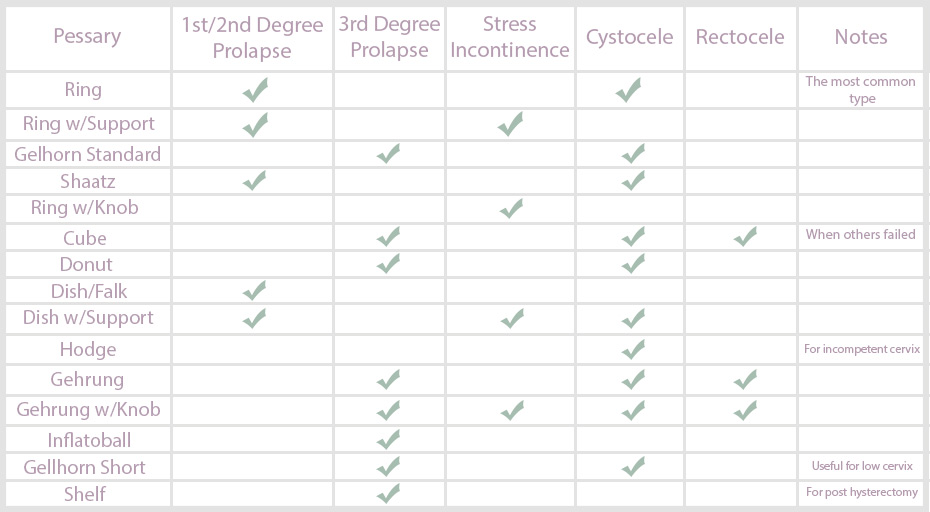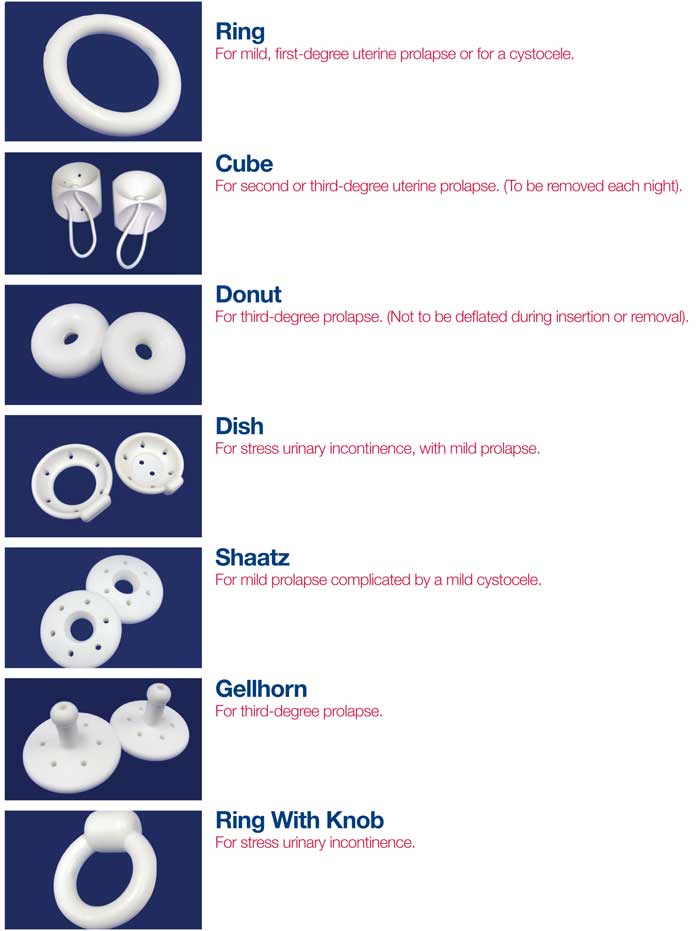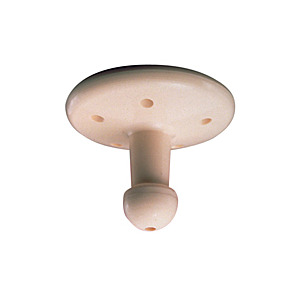Vaginal Pessary for Pelvic Support, Prolapse and Incontinence
What is a Vaginal Pessary?
A vaginal pessary is a rubber or silicone, removable device that is worn inside the vagina. It is designed to add pelvic support where the kegel muscles are weak and pelvic organs have prolapsed or are in danger of prolapse (falling down).
What shape pessary suits my condition?

- A cystocele (bladder prolapse) is treated with a ring pessary with support, one with a filled-in centre
- Prolapse of the uterus (womb prolapse) is treated with a hollow ring pessary, also known as a ring pessary without support.
- Stress incontinence is best treated with a pessary ring with a knob.
Various elements can also be combined into one pessary, for instance if you have stress incontinence and cystocele (bladder prolapse) you would benefit most from a pessary ring with both support and a knob
Why use a Vaginal Pessary?
- A pessary is a non-surgical approach to the treatment of pelvic organ prolapse (POP). 80% of Grade 1 and 2 pelvic prolapse sufferers can be treated with a ring-shaped pessary.
- If she is not able to undergo surgery due to chronic health problems, such as heart or lung disease a pessary is recommended.
- A pessary can also help sufferers of frequent urination (frequency incontinence) by supporting the bladder or putting pressure on the urethra.
- It can be used successfully to treat other gynaecologic conditions, such as a uterus that is in the wrong position.
- To prevent a possible prolapse in the cases of women who have asthma, hay fever or a permanent cough.
- Sports women and those participating in high impact exercise, especially after childbirth. Activities such as running, weight training and kick boxing really do stress the pelvic floor; a pessary can take the strain.
- When pelvic organ prolapse is present and she has not completed her family and wants more children.
- During pregnancy it adds support (only to be used under clinical guidance).
- If she has a uterine or vaginal prolapse during pregnancy (only to be used under clinical guidance).
Pelvic organ prolapse symptoms and incontinence can improve in many women who use a vaginal pessary, and for some the symptoms go away with pessary use.
Vaginal pessaries come in different sizes, shapes and types of materials and you'll find a varied choice, women are advised to experiment with different ones to find the most suitable design.
The most popular types of pessary are the inflatable pessary, the doughnut, and the Gellhorn pessary.
Vaginal Pessary Success is Clinically Proven
Medical research shows that a vaginal pessary can actually slow the development of pelvic organ prolapse and also improve the severity of prolapse.
Clinical studies have shown that genital hiatus wideness can be reduced with pessary use. The wider the genital hiatus the more relaxation in the pelvic floor muscles.
Pessary use reduces the genital hiatus width sometimes within just 2 weeks of use - others can range up to 3 months of use. Reducing the width of the genital hiatus can reduce your chance of prolapse.
Who can use a Vaginal Pessary?
Doctors and Continence Specialists have typically recommended a pessary for older women who are unsuitable for surgery or waiting for pelvic floor surgery, post-partum women or if specifically requested.
A pessary may not be suitable for all women and you may have to try a few styles until you find one that suits your body, but remember it is always best to ask your Doctor, Physiotherapist or continence advisor. Your healthcare provider will have a Pessary Set or a set of pessary fitting rings and they can help you find a pessary that is right for you.
If you are postmenopausal it is sometimes advisable to have a 2 to 3 month treatment of topical oestrogen. Topical oestrogen is a cream applied vaginally to prevent dryness or vaginal atrophy and plump-up the vaginal walls making them more comfortable before your pessary is fitted. Fitting your vaginal pessary should be comfortable, this will help make it successful and allow the pessary do the job of supporting your pelvic floor properly.
You might find that a vaginal pessary is not right for you if:
- You don't have a uterus, a pessary works best if you have a uterus so if you've had a hysterectomy pessary use may not be successful
- You have already had pelvic surgery for prolapse.
- If you have a wide vaginal opening
- If you have a short vagina
- If you have severe posterior vaginal wall prolapse
- If you have suffered previous SUI (Stress Urinary Incontinence)
What are the different styles of Pessaries and Ring Pessaries?

Who Should Not Use a Pessary?
Pessary use isn't for everyone; some women swear by them, others just can't get along with them. As a rule, you are recommended not to use a vaginal pessary if:- You have a vaginal infection
- Undiagnosed vaginal bleeding
- PID - pelvic inflammatory disease
What are the Risks and Problems of Pessary use?
If you use a pessary you could suffer with the any of the following; vaginal infection, erosions, discharge, vaginal odour, pelvic pain, and bleeding.- Sometimes a pessary does not reduce the symptoms of prolapse
- Sometimes the pessary might fall-out - so accurate fitting is essential.
- Your pessary should be removed and cleaned as recommended by your GP or following the manufacturer's instructions. If you are unable to maintain these levels of care then a pessary isn't for you.
How to care for your Pessary
Your pessary should be removed and inspected for wear, and washed with a mild soap and water. You can do this daily, weekly or monthly or at an interval that suits you.
Frequently Asked Questions about Pessary use.
Q. Do I have to remove my pessary when making love?
A. No, if you are fitted with a ring pessary, which is recommended for cystocele (bladder prolapse) you can leave the pessary ring in place when lovemaking.
Q. I am allergic to latex, can I use a pessary?
A. Yes, most pessaries are made in body friendly silicone.
Q. Will I be able to feel the pessary?
A. No, if your pessary is fitted properly you should not feel it at all and you should be able to continue with your normal daily activities.
Q. I find it difficult removing my pessary
A. If you find it difficult or uncomfortable to remove simply tie a long piece of dental floss to the pessary so that you can remove it easily. Make sure the dental floss is plain and not treated with a fluoride or minty coating.
Q. How long will my pessary last?
A. Check the manufacturer's recommendation. Some last up to 5 years, others recommend replacing after just six months. Make sure you check you pessary for signs of wear when you remove it for cleaning.
Q. I have been told that I am a 'high risk' of prolapse after a difficult labour with my daughter. I have an active lifestyle and I run and play tennis. Would using a pessary help me?
A. Yes, a pessary would be advisable to use as a preventative measure. It is easier to prevent a prolapse than treat a prolapse and a pessary will help support your pelvic floor, especially during high impact sports. A pessary can be very effective when used in combination with regular pelvic floor exercises to keep your muscles strong and supportive.
Q. I'm worried that the pessary might get lost, can that happen?
A. No, it can't get lost, and if it fits properly it will stay in your vagina and not fall out. The only other opening is at the top of the vagina through the cervix, but this is too small for a pessary to pass through.
Q. I had a mesh operation only 2 years ago and it has failed, I cannot go through the prolapse surgery again and I have been reading about the benefits of wearing a vaginal pessary. Will it help me?
A. You have had pelvic surgery previously, you might find that you are not suitable for pessary use but ask your healthcare provider. They will have a pessary ring fitting set and you can be fitted with one to see if it suits your needs.
Q. I have to go for an X-Ray can I wear my pessary as usual?
A. No, some silicone pessaries contain metal, so it is advised that you remove your vaginal pessary for X-rays and MRI scans.
Q. Can I use a lubricant with my pessary?
A. Yes a good quality lubricant will help to make fitting and removal of the pessary more comfortable. Make sure you use a water-based lubricant, rather than a silicone or petroleum based one. Silicone lube can react with the silicone in the pessary and petroleum based lubricants are not body friendly.
Q. I wear my pessary daily to prevent stress incontinence, popping it in when I have a shower and removing it last thing at night. My GP has mentioned I might be a case for hysterectomy; would I still be able to use the pessary after the operation?
A. Ideally a pessary needs a uterus to work and if you have your uterus removed there may not be enough support for one. You would have to try different styles, but usually after hysterectomy pessary use is not always successful.


